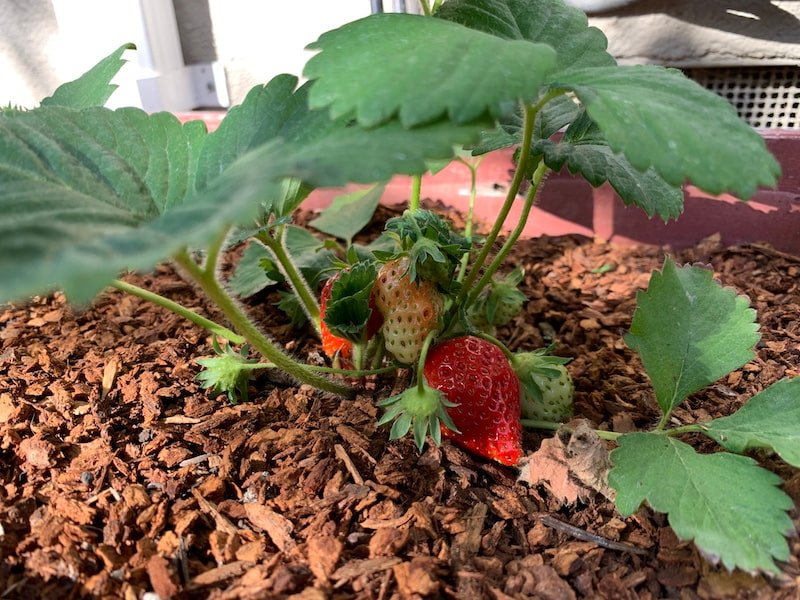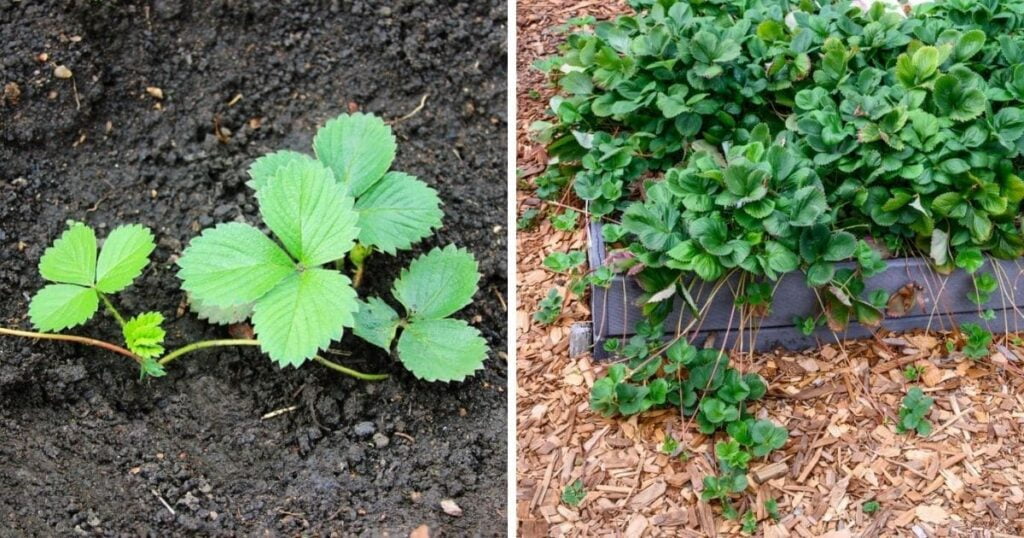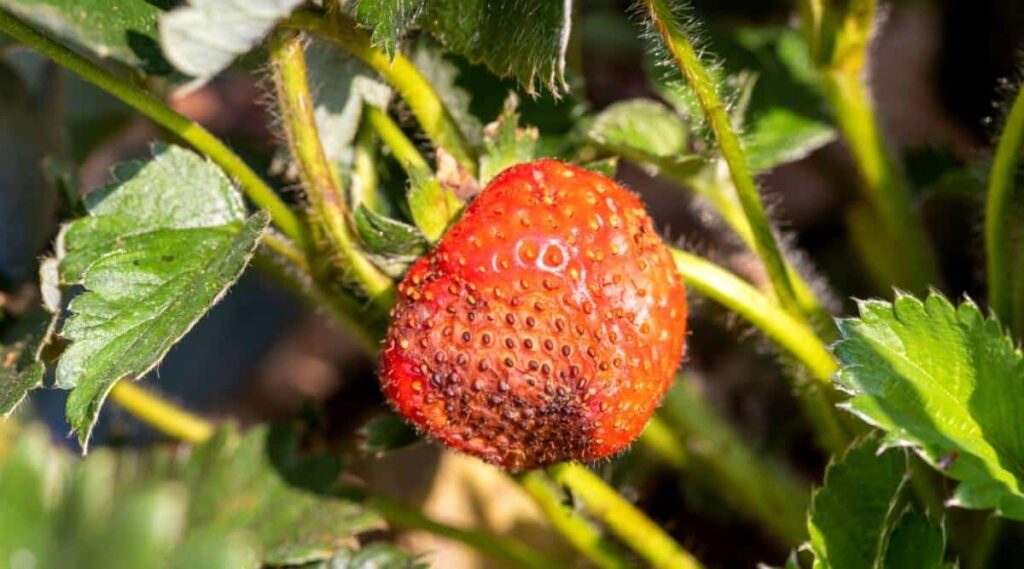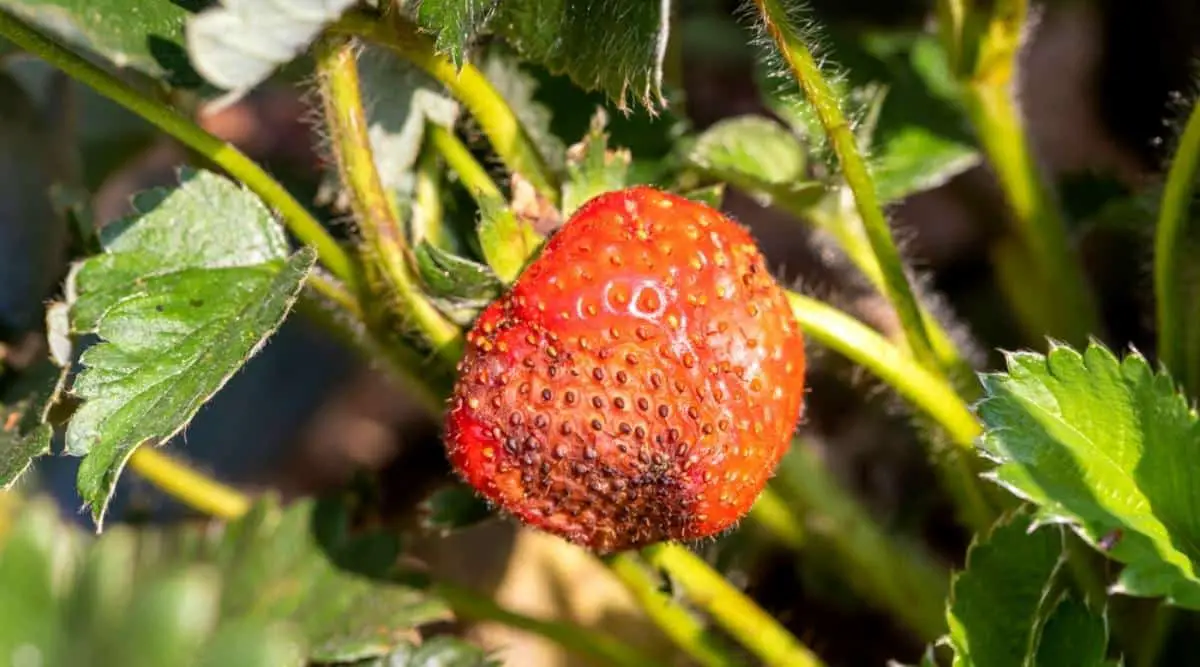In the realm of horticulture, there exists a perplexing phenomenon where the strawberry plant, a staple in many gardens, fails to produce its coveted fruit. While one may anticipate and eagerly await a bountiful harvest, the absence of these delectable red berries can be disheartening and leave gardeners puzzled. Unraveling the mystery behind why a strawberry plant won’t produce fruit requires a deeper understanding of its intricate biology and various factors that contribute to successful fruiting. By examining the intricacies of pollination, fertilization, environmental conditions, and plant care, one can uncover the reasons behind this unexpected setback and discover potential solutions to cultivate a thriving strawberry crop.

Common Causes
Lack of Pollination
One common cause of a strawberry plant not producing fruit is a lack of pollination. Strawberries are typically pollinated by bees, butterflies, hummingbirds, or even the wind. Without adequate pollination, the flowers on the strawberry plant will not develop into fruit. Lack of pollination can occur due to a shortage of pollinators in the area or environmental conditions that prevent effective pollination.
Improper Plant Spacing
Improper plant spacing can also hinder fruit production in strawberry plants. When plants are spaced too closely together, they compete for resources such as sunlight, water, and nutrients. This competition can result in weakened plants that are more focused on survival rather than producing fruit. It is important to provide enough space between strawberry plants to allow for proper growth and development.
Poor Soil Conditions
The quality of the soil plays a crucial role in the productivity of strawberry plants. Poor soil conditions, such as inadequate drainage or nutrient deficiencies, can prevent the plants from producing fruit. In poorly drained soil, excess water can accumulate around the plants’ roots, causing root rot and hindering their ability to take up nutrients. Additionally, nutrient deficiencies, such as a lack of nitrogen, phosphorus, or potassium, can severely impact the plants’ ability to grow and produce fruit.
Insufficient Sunlight
Sunlight is essential for the photosynthesis process, which provides the necessary energy for fruit production in strawberry plants. If the plants are not receiving enough sunlight, their growth and fruiting potential can be severely hindered. Plants that are shaded by nearby trees or structures may not be able to absorb an adequate amount of sunlight, leading to a lack of fruit production. It is important to ensure that strawberry plants are planted in an area with sufficient sunlight to maximize their productivity.
Planting and Care Issues
Age of the Plant
The age of the strawberry plant can influence its ability to produce fruit. Generally, younger plants tend to prioritize establishing their root systems and foliage growth rather than fruit production. It is common for strawberry plants to take one to two years to reach full fruiting potential. If your strawberry plant is still relatively young, it may simply need more time to mature and develop before producing a significant amount of fruit.
Improper Pruning
Pruning is an essential aspect of caring for strawberry plants, but improper pruning techniques can hinder fruit production. Over-pruning can remove too many leaves and stems, reducing the plant’s ability to photosynthesize and produce energy. On the other hand, failing to prune the plants can result in overcrowding, which limits airflow and sunlight penetration to the center of the plants. Proper pruning techniques, such as removing runners and dead leaves, ensure that the strawberry plants maintain a balance between foliage growth and fruit production.
Improper Fertilization
Fertilization is vital for providing the necessary nutrients to strawberry plants to support their growth and fruit production. However, improper fertilization can cause more harm than good. Applying excessive amounts of fertilizer can lead to nitrogen burn or nutrient imbalances that negatively affect plant health and fruit production. Conversely, insufficient fertilization can result in nutrient deficiencies, limiting the plants’ ability to produce fruit. It is crucial to follow proper fertilization guidelines and conduct soil tests to determine the specific nutrient requirements of your strawberry plants.
Lack of Water
Proper watering is essential for the overall health and productivity of strawberry plants. Insufficient water can cause stress to the plants, hindering their ability to produce fruit. Without enough water, the plants may not be able to transport nutrients effectively, leading to a halt in fruit production. On the other hand, overwatering can result in waterlogged soil, which can suffocate the plant roots and cause root rot. Finding the right balance and consistently providing adequate water to strawberry plants is crucial for optimal fruit production.

Pest and Disease Problems
Aphid Infestation
Aphids are common pests that can cause significant damage to strawberry plants. These small insects feed on the sap of the plants, weakening them and potentially transmitting diseases. If left untreated, aphids can hinder fruit production by stunting the growth of the plants and causing deformities in the fruit. Regular monitoring and appropriate pest control measures, such as the use of insecticidal soaps or natural predators, can help prevent aphid infestations and maintain healthy strawberry plants.
Powdery Mildew
Powdery mildew is a fungal disease that commonly affects strawberry plants, particularly in humid environments. This disease appears as a white, powdery coating on the leaves and stems of the plants. The presence of powdery mildew can hinder fruit production by reducing photosynthesis and weakening the overall health of the plants. Proper plant spacing, regular monitoring, and the application of fungicides can help prevent and control powdery mildew and ensure optimal fruit production.
Spider Mite Infestation
Spider mites are tiny arachnids that can cause significant damage to strawberry plants. These pests feed on the plant’s sap, resulting in yellowing leaves, stunted growth, and webbing on the foliage. Spider mite infestations can hinder fruit production by weakening the plants and reducing their ability to photosynthesize. Regular inspection, the use of water sprays to dislodge mites, and the introduction of natural predators can help manage spider mite infestations and promote healthy fruit production.
Gray Mold
Gray mold, caused by the fungus Botrytis cinerea, is a common disease that affects strawberry plants. This fungal infection typically develops in cool, damp conditions and can spread rapidly throughout the plant. Gray mold can inhibit fruit production by causing fruit rot and premature fruit drop. Proper plant spacing, good airflow, and the removal of infected plant material can help prevent and control gray mold and its impact on fruit production.
Environmental Factors
Extreme Temperatures
Extreme temperatures, both hot and cold, can adversely affect fruit production in strawberry plants. High temperatures can cause stress to the plants and lead to flower drop or reduce pollen viability, resulting in a lack of fruit development. Conversely, exposure to freezing temperatures or frost can damage the flowers and young fruits, leading to their failure to mature. Providing shade during periods of excessive heat and implementing frost protection measures during cold spells can mitigate the negative effects of extreme temperatures on fruit production.
Frost Damage
Frost is a common environmental factor that can damage strawberry plants and hinder fruit production. Exposure to frost can cause freezing injury to the flowers and young fruits, resulting in browning, wilting, or outright death of the affected plant parts. To minimize frost damage, it is essential to cover the plants with protective materials, such as frost blankets or straw, during cold nights or early spring frosts. Additionally, planting strawberry varieties that are more tolerant of low temperatures can reduce the risk of frost damage and promote fruit production.
Excessive Rainfall
While strawberry plants require adequate water, excessive rainfall can have detrimental effects on fruit production. Heavy and prolonged rainfall can lead to waterlogged soil, depriving the plant roots of oxygen and causing root rot. The excessive moisture can also promote the growth of fungal diseases, such as gray mold. To mitigate the negative effects of excessive rainfall, ensuring proper soil drainage, raising the planting beds, and providing adequate protection from excessive rain can help maintain optimal fruit production.
Drought Conditions
On the other end of the spectrum, drought conditions can also hinder fruit production in strawberry plants. Insufficient water availability can cause stress to the plants, resulting in smaller fruit sizes or a lack of fruit altogether. It is crucial to establish a regular watering schedule, especially during dry periods, to ensure that the strawberry plants receive adequate moisture for optimal growth and fruit production. Mulching around the plants can also help conserve soil moisture and reduce water loss through evaporation.

Wrong Variety Selection
Day-Neutral Varieties
The selection of the wrong strawberry variety can significantly impact fruit production. Day-neutral varieties are a type of strawberry plant that can produce fruit continuously throughout the growing season, regardless of the day length. While this may seem advantageous, day-neutral varieties tend to have lower overall yields compared to other types. If your goal is to maximize fruit production, choosing June-bearing or everbearing varieties might be more suitable, as they have specific fruiting periods that yield larger quantities of fruit.
June-Bearing Varieties
June-bearing varieties are strawberry plants that produce a single, concentrated crop during the early summer months. These varieties typically yield a large number of berries during this period but do not produce significant amounts of fruit throughout the rest of the growing season. If your strawberry plant belongs to a June-bearing variety, it is crucial to correctly identify the fruiting period and manage your expectations accordingly. The lack of fruit production outside the specific fruiting period is a natural characteristic of these varieties.
Everbearing Varieties
Everbearing varieties, as the name suggests, produce fruit multiple times throughout the growing season. These plants typically have two main fruiting periods, one in early summer and another in late summer to early fall. Everbearing varieties generally yield fewer berries per harvest compared to June-bearing varieties. However, their ability to produce fruit over a more extended period can result in a higher overall yield throughout the growing season. Understanding the fruiting patterns and characteristics of different strawberry varieties is crucial for maximizing fruit production based on your specific needs and goals.
Lack of Proper Pollinators
Bees
Bees play a vital role in the pollination of strawberry plants. These buzzing insects are attracted to the flowers’ nectar and transfer pollen from the male parts of the flower to the female parts, enabling fruit development. However, a lack of bees or other pollinators in the area can lead to inadequate pollination and, consequently, a lack of fruit production. Encouraging bee populations by planting pollinator-friendly flowers nearby, providing nesting spaces, and avoiding the use of harmful pesticides can help ensure sufficient pollination and maximize fruit production.
Butterflies
Although not as effective as bees, butterflies can also contribute to the pollination of strawberry plants. Their visitation to the flowers helps transfer pollen and promote fruit development. Installing butterfly-friendly plants in the garden, such as milkweed or coneflowers, can attract butterflies and enhance pollination. However, it is important to note that butterflies alone may not provide as efficient pollination as bees, so encouraging a diverse population of pollinators is beneficial for optimal fruit production.
Hummingbirds
In certain regions, hummingbirds can act as pollinators for strawberry plants. Their long beaks and ability to hover make them effective at accessing the flowers and transferring pollen. Planting hummingbird-friendly flowers, such as trumpet vine or bee balm, can attract these beautiful birds and increase the chances of successful pollination. However, it is important to note that hummingbirds may not be as abundant or widespread as other pollinators, so their contribution to fruit production may vary depending on the specific area.
Wind
While natural pollinators are the preferred method for strawberry plant pollination, wind can also play a role, especially in open-field cultivation. The movement and vibrations created by wind can cause the release of pollen from the flowers and help facilitate fertilization. Open planting arrangements that allow for better airflow can maximize the potential for wind pollination. However, relying solely on wind for pollination may not be as efficient as having an active population of bees or other pollinators present.

Improper Plant Care Timing
Late Planting
The timing of planting strawberry plants can significantly impact their fruit production. Late planting, especially in regions with shorter growing seasons, can result in a delay in fruiting or a complete lack of fruit altogether. Strawberry plants have specific chilling and dormancy requirements to trigger flower and fruit development. If the plants are not planted early enough to allow for proper establishment and chilling hours, they may not transition into the fruiting stage. Planting strawberries at the recommended time based on your specific climate and growing conditions is essential for optimal fruit production.
Early Blossom Removal
Blossom removal is a common practice in strawberry cultivation to redirect the plant’s energy towards vegetative growth and encourage the development of a robust root system. However, improper timing of blossom removal can hinder fruit production. Removing the flowers too early in the plant’s life cycle can prevent fruit development altogether, as the necessary pollination process is disrupted. It is crucial to follow proper blossom removal guidelines and consider the stage of plant development to maintain a balance between vegetative growth and fruit production.
Improper Weed Control
Weeds compete with strawberry plants for resources such as water, nutrients, and sunlight. If weeds are not adequately controlled, they can negatively impact fruit production by reducing the available resources for the strawberry plants. Weeds can overshadow the plants, limiting sunlight penetration, and potentially harbor pests and diseases that can further hinder fruit production. Implementing effective weed control measures, such as regular removal or mulching, is essential to ensure that the strawberry plants have the optimal conditions for fruit development.
Late Harvesting
Proper timing of harvesting is critical to maximize fruit production in strawberry plants. Late harvesting can negatively impact future yield by diverting the plant’s energy towards fruit ripening rather than new flower and fruit development for the next season. It is important to harvest strawberries at the appropriate stage of ripeness and not wait until they become overripe. Regularly monitoring the ripeness of the fruits and promptly harvesting them when ready can maintain a healthy fruiting cycle and promote continued fruit production.
Improper Ventilation
Crowded Plantings
Overcrowding strawberry plants can hinder ventilation within the planting area, leading to increased humidity levels and reduced airflow. Insufficient ventilation can create an ideal environment for the development of fungal diseases, such as gray mold or powdery mildew. These diseases can impact fruit production and overall plant health. Proper plant spacing and regular thinning or removal of excess runners can help maintain adequate ventilation within the strawberry planting area and prevent the buildup of humidity.
Overgrown Garden
An overgrown garden can limit airflow and light penetration, creating unfavorable conditions for strawberry plants. If the garden is densely populated with tall plants or unpruned shrubs and trees, the strawberry plants may not receive sufficient sunlight or air circulation to support fruit production. Regular maintenance, including pruning and removing excessive vegetation, can prevent overcrowding and improve ventilation within the garden, allowing the strawberry plants to thrive and produce fruit.
Lack of Air Circulation
Similar to overcrowding, a lack of air circulation can hinder fruit production in strawberry plants. Stagnant air can increase humidity levels and prevent the evaporation of excess moisture, creating conditions that favor the development of fungal diseases. Providing adequate spacing between plants and incorporating features such as trellises or support systems can promote air circulation and reduce the risk of disease occurrence. Additionally, strategic plant placement in areas with good air movement, such as open fields or areas with prevailing winds, can further enhance ventilation around the strawberry plants.

Soil Nutrient Deficiencies
Nitrogen Deficiency
Nitrogen is a crucial nutrient for overall plant growth and fruit production. A deficiency in nitrogen can result in stunted growth, yellowing leaves, and a lack of fruit development in strawberry plants. Nitrogen deficiency is often characterized by pale green or yellow foliage and reduced vigor. Conducting a soil test can help identify nitrogen deficiencies and allow for targeted fertilization to meet the plants’ needs. Applying nitrogen-rich fertilizers or organic amendments, such as compost or manure, can help correct nitrogen deficiencies and promote healthy fruit production.
Phosphorus Deficiency
Phosphorus is essential for energy transfer and proper fruit development in strawberry plants. A deficiency in phosphorus can lead to poor root development, weak plants, and a lack of fruit production. Plants affected by phosphorus deficiency may exhibit stunted growth and purplish discoloration on the foliage. Phosphorus deficiencies are often more common in acidic soils or those with poor nutrient availability. Incorporating phosphorus-rich fertilizers or amendments, such as bone meal or rock phosphate, into the soil can correct phosphorus deficiencies and support optimal fruit production.
Potassium Deficiency
Potassium plays a crucial role in the overall health and fruit production of strawberry plants. A deficiency in potassium can result in yellowing leaves, weak plants, and reduced fruit size or quality. Potassium-deficient plants may also exhibit increased susceptibility to pests and diseases. Conducting a soil test can help determine potassium deficiencies and guide appropriate fertilization practices. Applying potassium-based fertilizers or organic amendments, such as wood ash or potassium sulfate, can correct deficiencies and promote healthy fruit production.
Micronutrient Deficiencies
In addition to macronutrients, strawberry plants require various micronutrients for optimal growth and fruit production. Micronutrients, such as iron, manganese, and zinc, are necessary for essential plant processes and enzyme activities. Deficiencies in these micronutrients can manifest as yellowing or chlorosis of the leaves, stunted growth, or abnormal fruit development. Conducting a soil test can help identify specific micronutrient deficiencies, allowing for targeted fertilization or foliar applications to address these issues. It is important to maintain a balanced nutrient profile and ensure that all necessary micronutrients are present for healthy fruit production.
Inadequate Plant Health
Viral Infections
Strawberry plants can be susceptible to various viral infections, which negatively impact their overall health and fruit production. Viruses, such as Strawberry Mosaic Virus or Strawberry Crinkle Virus, can cause stunted growth, leaf mottling or distortion, and reduced fruit size or quantity. Once infected, strawberry plants cannot be cured of viral infections, and affected plants should be promptly removed to prevent the spread of the disease. Implementing good sanitation practices, using disease-free planting material, and controlling potential virus vectors, such as aphids, can help prevent viral infections and maintain plant health.
Bacterial Infections
Bacterial infections can also negatively affect strawberry plant health and fruit production. Diseases like bacterial crown rot or bacterial angular leaf spot can cause wilting, rotting of the crown or fruit, and reduced yields. Bacterial infections are often challenging to control, and prevention is key. Using disease-resistant varieties, implementing proper sanitation practices, and avoiding overhead watering that can facilitate the spread of bacteria are essential in preventing bacterial infections. If bacterial infections occur, prompt removal and destruction of infected plants are necessary to prevent further spread.
Fungal Diseases
Multiple fungal diseases can impact the health and fruit production of strawberry plants. Diseases such as gray mold, powdery mildew, or root rot can cause various symptoms, including fruit rot, leaf discoloration, or wilting. Fungal spores can survive in the soil or on plant debris, making prevention and management crucial. Implementing proper sanitation practices, such as the removal of infected plant material, and regular monitoring can help identify and address fungal diseases before they severely impact fruit production. The use of fungicides and employing cultural practices such as proper plant spacing and airflow can further assist in managing fungal diseases.
Root Rot
Root rot, caused by certain fungi or waterlogged conditions, can significantly compromise the health of strawberry plants and limit fruit production. Excessive moisture and poor soil drainage create an environment where root rot pathogens thrive, leading to root decay and reduced nutrient uptake. Symptoms of root rot include stunted growth, yellowing leaves, and wilting. Preventing root rot involves ensuring proper soil drainage, practicing good watering techniques, and avoiding overwatering. Additionally, the use of disease-resistant varieties and regular root inspections can help detect and address root rot in its early stages, minimizing its impact on fruit production.



